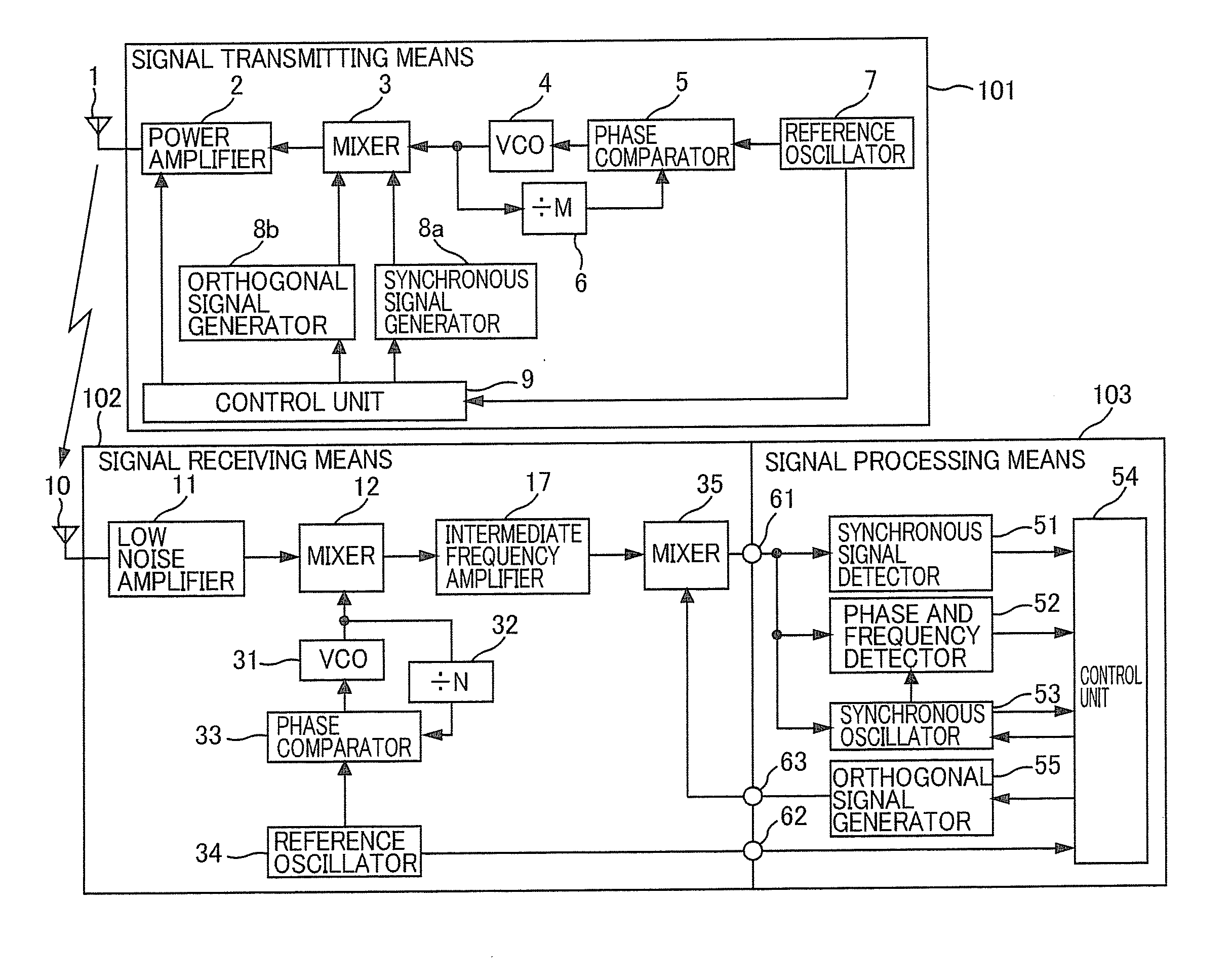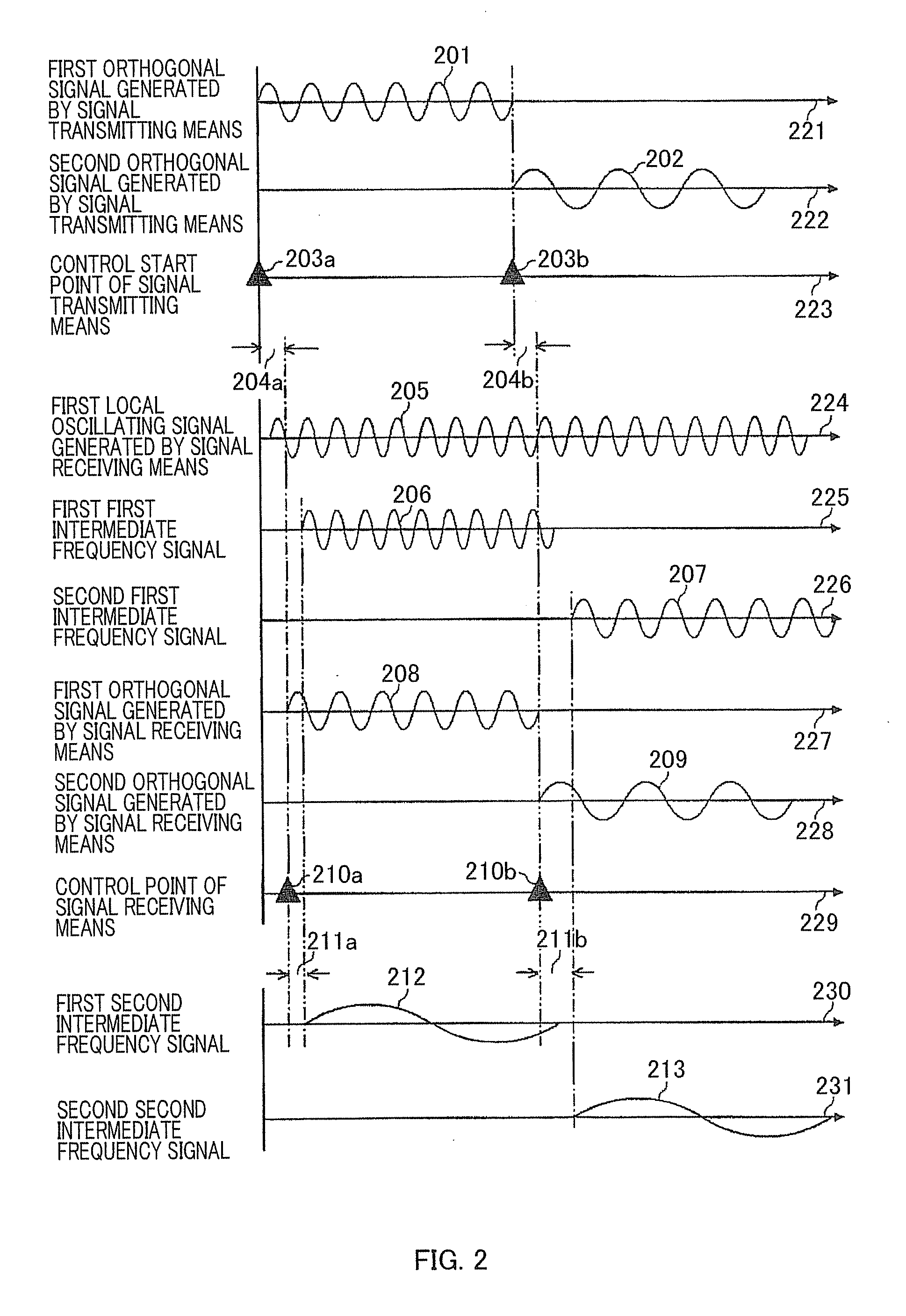Distance measuring device
- Summary
- Abstract
- Description
- Claims
- Application Information
AI Technical Summary
Benefits of technology
Problems solved by technology
Method used
Image
Examples
embodiment 1
[0044]FIG. 1 is a block diagram showing a distance measuring device according to a first embodiment of the present invention, and FIG. 2 is a diagram showing exemplary flows of signals. In FIG. 1, reference numeral 101 denotes a signal transmitting means, reference numeral 1 denotes an antenna, reference numeral 2 denotes a power amplifier, reference numeral 3 denotes a mixer, reference numeral 4 denotes a voltage-controlled oscillator, reference numeral 5 denotes a phase comparator, reference numeral 6 denotes a frequency divider, reference numeral 7 denotes a reference oscillator, reference numeral 8a denotes a synchronous signal generator, reference numeral 8b denotes an orthogonal signal generator, and reference numeral 9 denotes a control unit. Furthermore, reference numeral 102 denotes a signal receiving means, reference numeral 10 denotes an antenna, reference numeral 11 denotes a low noise amplifier, reference numeral 16 denotes a first mixer, reference numeral 17 denotes a ...
embodiment 3
[0072]FIG. 3 is a diagram showing a distance measuring device according to an embodiment 2 of the present invention. In FIG. 3, reference numeral 102 denotes a signal receiving means, reference numeral 10 denotes an antenna, reference numeral 11 denotes a low noise amplifier, reference numeral 16 denotes a mixer, reference numeral 17 denotes an intermediate frequency amplifier, reference numeral 31 denotes a voltage-controlled oscillator, reference numeral 32 denotes a frequency divider, reference numeral 33 denotes a phase comparator, reference numeral 35 denotes a reference oscillator, reference numeral 103 denotes a signal processing means, reference numeral 51 denotes a synchronous signal detector, reference numeral 52 denotes a phase and frequency detector, reference numeral 53 denotes a synchronous oscillator, reference numeral 54 denotes a control unit, reference numeral 56 denotes a frequency multiplier / divider, and reference numerals 61 and 62 denote connection points.
[0073...
embodiment 4
[0129]FIG. 9 is a diagram showing a configuration of a distance measuring device according to a fourth embodiment of the present invention. In FIG. 9, reference numerals 1a and 1b denote a plurality of antennas connected to a signal transmitting means 101, reference numeral 1c denotes an antenna switching means for switching between the plurality of antennas 1a and 1b, reference numerals 10a and 10b denote a plurality of antennas connected to a signal receiving means 102, reference numeral 10c denotes an antenna switching means for switching between the plurality of antennas 10a and 10b, and reference numeral 66 denotes a connection point between the control unit 54 and the antenna switching means 10c. The remaining components are the same as those shown in FIG. 1.
[0130]The plurality of antennas 1a, 1b and / or the plurality of antennas 10a, 10b are disposed at intervals equal to or smaller than the wavelength of the carrier signal or sub-carrier signal of the radio frequency signal a...
PUM
 Login to View More
Login to View More Abstract
Description
Claims
Application Information
 Login to View More
Login to View More - R&D
- Intellectual Property
- Life Sciences
- Materials
- Tech Scout
- Unparalleled Data Quality
- Higher Quality Content
- 60% Fewer Hallucinations
Browse by: Latest US Patents, China's latest patents, Technical Efficacy Thesaurus, Application Domain, Technology Topic, Popular Technical Reports.
© 2025 PatSnap. All rights reserved.Legal|Privacy policy|Modern Slavery Act Transparency Statement|Sitemap|About US| Contact US: help@patsnap.com



